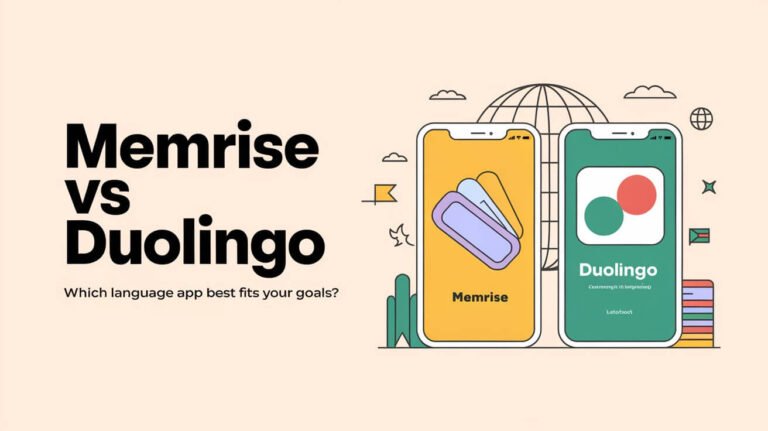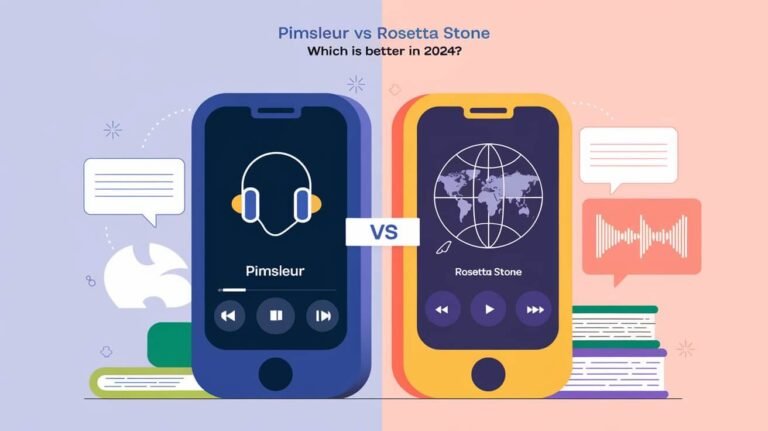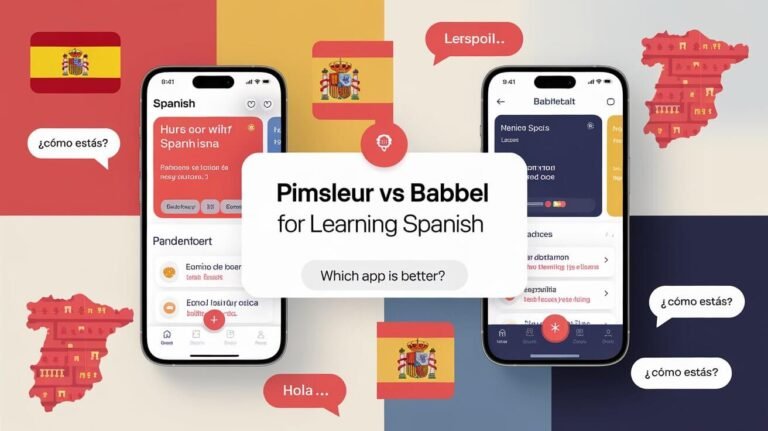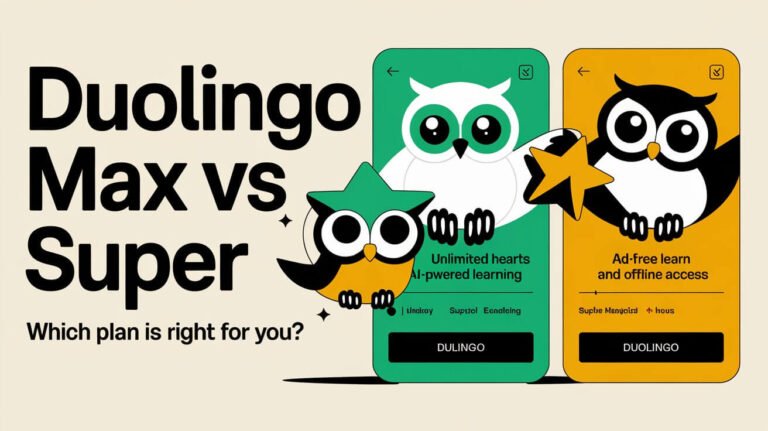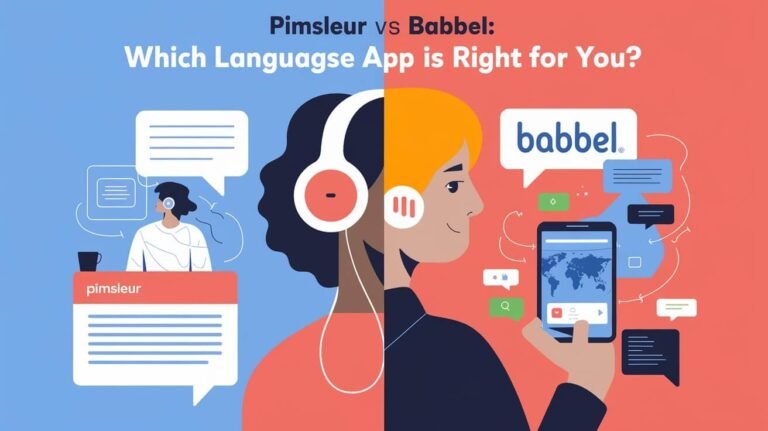Babbel Vs Duolingo: Choosing the Best Language App
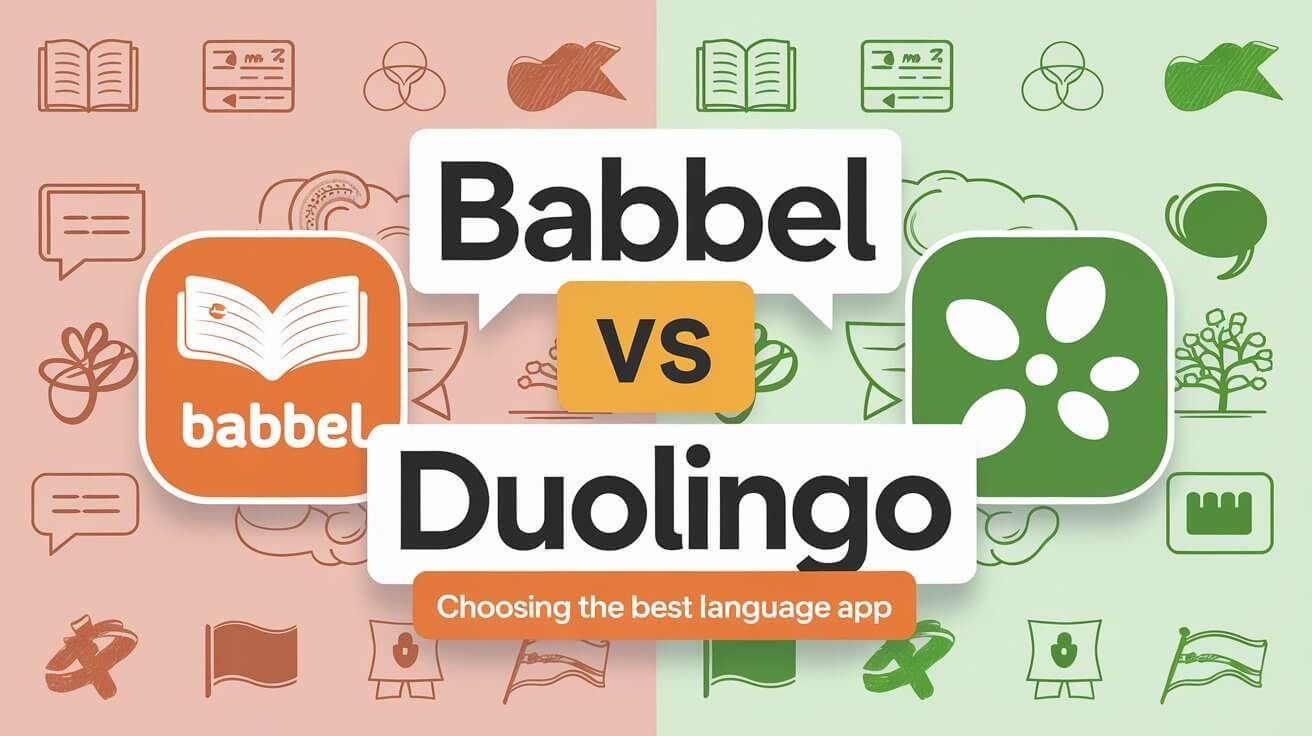
In the fast-changing world of mobile language learning, Babbel and Duolingo are at the forefront. They offer different ways to learn new languages, appealing to many learners. Duolingo is known for its free, fun lessons, while Babbel offers a paid service with a more detailed approach.
Language lovers are always debating which app is better. This comparison will look closely at Babbel and Duolingo. We’ll examine their language options, teaching methods, user experience, speech recognition, and prices. By the end, you’ll know which app is right for you.
Language Coverage and Platform Comparison
Babbel and Duolingo are top choices for learning languages. They both aim to improve your language skills. But, they differ in languages offered and user experience.
Available Languages on Both Platforms
Babbel and Duolingo share 13 languages like French, German, and Spanish. But, Duolingo offers 40+ languages, leading Babbel’s 14 languages, including English.
Platform Interface and Design Elements
Duolingo’s design is fun, with cartoons and rewards. It keeps you engaged with short lessons. Babbel, on the other hand, is more serious and adult-focused, aiming for a structured learning experience.
Mobile and Desktop Accessibility
Both platforms have apps and desktop versions. This means you can learn anywhere, anytime. It’s great for studying on the move or focused sessions on a computer.
Choosing between Babbel and Duolingo depends on your learning style and goals. Both platforms have their benefits. They cater to different needs, making them good options for language learners.
The Real Cost Behind Free and Paid Options
Choosing between free and paid language learning apps is key. Duolingo offers a free version with ads and a premium service called “Duolingo Plus” for $6.99 a month. Babbel, a paid service, costs between $8 and $15 monthly.
Duolingo used to rely on user translations for money. Now, it makes money from ads and premium subscriptions. Babbel, with its expert-designed content, charges more for its quality.
| Feature | Duolingo | Babbel |
|---|---|---|
| Pricing | Free with ads, $6.99/month for Duolingo Plus | $8 to $15 per month |
| Language Coverage | 40+ languages, some in beta | 14 languages |
| Content Quality | Gamified, bite-sized lessons | Professionally designed, focused on real-life scenarios |
| Offline Access | Not available in free version, included in Duolingo Plus | Included in all subscription plans |
Duolingo’s free version is fun and engaging. Babbel’s paid service offers more, like professional guidance and offline access. Your choice depends on what you value more.
Babbel Vs Duolingo Teaching Approaches
Babbel and Duolingo have different ways of teaching languages. Babbel’s lessons are longer, lasting 10 to 15 minutes. They follow a structured format. Duolingo’s lessons are shorter, lasting 5 to 10 minutes. They have a game-like feel.
Lesson Structure Differences
Babbel focuses on practical language use. It includes exercises that challenge learners in real-world scenarios. These exercises cover listening, speaking, reading, and writing.
Duolingo, on the other hand, uses repetitive, gamified exercises. It emphasizes vocabulary retention through a simple, linear learning path.
Learning Path Organization
Duolingo’s learning path is structured with locked units. It guides learners through a set sequence of lessons. Babbel offers more flexibility. Learners can choose their own path and progress at their own pace.
Exercise Types and Formats
Both Babbel and Duolingo use various exercise types. These include listening, speaking, reading, and writing tasks. Babbel’s exercises are more challenging and practical. Duolingo’s exercises are repetitive and gamified, focusing on vocabulary.
| Feature | Babbel | Duolingo |
|---|---|---|
| Lesson Duration | 10-15 minutes | 5-10 minutes |
| Lesson Structure | More structured, focused on practical language use | More game-like, emphasizing vocabulary retention |
| Learning Path | Flexible, self-paced | Linear, with locked units |
| Exercise Types | Listening, speaking, reading, writing | Listening, speaking, reading, writing |
| Exercise Formats | More challenging, focused on practical use | More repetitive, gamified |
Speech Recognition and Verbal Practice Features
Language learning apps need to let you practice speaking and get feedback on how you sound. Babbel and Duolingo both use speech recognition tech for this. But they do it in different ways and to different extents.
Babbel is known for its detailed speaking exercises. These lessons are all about real-life conversations. You get feedback on your pronunciation, which is a big help.
Duolingo, on the other hand, has simpler speaking tasks. It asks you to repeat words or phrases. While it’s fun, it doesn’t offer as much help with speaking and pronunciation as Babbel does.
It’s important to know that neither Babbel nor Duolingo is the best for speaking practice. Pimsleur is a better choice if you want to improve your speaking skills. It has more advanced speaking exercises and better voice recognition tech.
| Feature | Babbel | Duolingo |
|---|---|---|
| Speech Recognition Technology | More robust, with better context and accurate feedback | More limited, often focusing on word or phrase repetition |
| Verbal Practice Depth | Moderate focus on practical conversation and pronunciation | Light focus on verbal practice, with a greater emphasis on gamification |
| Industry Comparison | Not considered industry-leading, but stronger than Duolingo | Not considered industry-leading, with alternatives like Pimsleur offering more comprehensive speaking exercises |
Grammar Instruction Quality Analysis
Language learning apps vary in how they teach grammar. Babbel and Duolingo take different paths, meeting different learner needs. This makes choosing between them a big decision.
Grammar Integration Methods
Babbel mixes grammar lessons into its courses. It offers clear explanations and practical exercises. This helps learners understand the language better.
Duolingo, on the other hand, focuses less on grammar. It uses short explanations and fun activities to teach basic sentences. This method helps learners get familiar with the language.
Practice Exercise Effectiveness
Babbel’s exercises help learners apply what they’ve learned. They include fill-in-the-blank and sentence building tasks. This ensures learners can use their grammar skills.
Duolingo also teaches grammar but in a different way. Its exercises are not as detailed as Babbel’s. Instead, it repeats basic sentence patterns to build vocabulary.
If you want to learn a lot about language structure and grammar lessons, Babbel might be better. But, if you’re just starting or want to focus on vocabulary, Duolingo could be the way to go.
User Interface and Experience Design
Babbel and Duolingo have different ways of designing their user interfaces. Babbel focuses on a clean, professional look. It’s great for those who want a serious, structured way to learn a language.
Duolingo, on the other hand, is all about fun. It uses cartoon characters, bright colors, and rewards to keep learning exciting. This makes it perfect for people who enjoy a light-hearted, interactive learning experience.
- Babbel’s design prioritizes content and structured lessons, while Duolingo emphasizes app design and user engagement.
- Duolingo’s gamified approach can be more appealing to users who enjoy a playful, interactive learning experience.
- Babbel’s interface may be more suitable for learners who prefer a more professional, focused learning environment.
Choosing between Babbel and Duolingo depends on what you like. Both apps aim to be easy to use. But, they cater to different learning styles.
Pronunciation and Speaking Skills Development
Babbel and Duolingo help with pronunciation and speaking, but in different ways. Babbel focuses on real-life dialogues and scenarios. This helps learners practice language in context. Its voice recognition technology is seen as more accurate and reliable, offering detailed feedback to enhance your language fluency and oral communication.
Voice Recognition Technology Comparison
Babbel’s speech recognition technology gives precise feedback on your pronunciation. It points out areas for improvement. Duolingo’s speaking exercises are more limited, often just repeating words or phrases. Babbel’s technology is considered more advanced and effective in assessing your speaking skills.
Speaking Exercise Formats
- Babbel offers a wide range of speaking exercises. These include role-playing, conversational simulations, and recording and playback options to improve your pronunciation.
- Duolingo’s speaking exercises are fun and engaging. They focus on vocabulary and grammar through repetitive drills and word-level feedback.
- Neither app fully develops conversational language fluency and oral communication skills. But Babbel is better for practicing and improving your pronunciation and speaking abilities.
“Babbel’s speaking exercises are more contextual and better suited for developing practical conversational skills, while Duolingo’s approach is more focused on vocabulary and grammar practice through repetitive drills.”
Babbel is better for improving pronunciation and speaking skills. It has advanced voice recognition technology and a variety of speaking exercises. For those looking to boost their language fluency and oral communication abilities, Babbel is the better choice.
Progress Tracking and Assessment Methods
Babbel and Duolingo have different ways to track your progress in language learning. Duolingo uses a fun system with XP points, levels, and daily streaks to keep you motivated. Babbel, on the other hand, shows your progress with traditional indicators like completed lessons and CEFR levels.
Duolingo checks your language skills with progress quizzes now and then. Babbel lets you focus on areas like flashcards, listening, speaking, or writing with customizable review sessions. But neither app gives official language proficiency certificates, which might matter if you need formal proof of your skills.
| Feature | Babbel | Duolingo |
|---|---|---|
| Progress Tracking | Traditional progress indicators, CEFR level estimates | Gamified system with XP points, levels, and daily streaks |
| Assessments | Customizable review sessions (flashcards, listening, speaking, writing) | Periodic progress quizzes |
| Proficiency Certifications | None | None |
Both Babbel and Duolingo have great ways to track your progress and check your skills. But, your choice might depend on how you like to learn and if you need a formal certificate.
Live Classes and Community Features
The social side of learning a new language is very important. Both Babbel and Duolingo have community features, but they work in different ways.
Babbel, a paid app, offers live classes. These classes have up to 6 students and are taught by experts. They cover various topics and skill levels. This way, students get a personalized learning experience and can practice their language skills with a teacher’s help.
Duolingo, a free app, now focuses only on app-based learning. It has stopped its online events and classes. Even though Duolingo doesn’t have live classes, its forums are very active. Users help improve courses and talk about their progress.
The Duolingo community is great for language exchange and learning from others. Users can meet other learners, share their achievements, and work together on course updates. This interactive approach is good for those who like a community-driven learning experience.
| Feature | Babbel | Duolingo |
|---|---|---|
| Live Classes | ✓ | ✗ |
| Community Engagement | Limited | High |
| Course Contribution | ✗ | ✓ |
Babbel provides structured live classes for those who want personalized teaching. Duolingo, on the other hand, has a lively online community for language exchange and course improvement. Your choice depends on what you prefer in learning and how much you value community interaction.
Content Quality and Natural Language Usage
Babbel stands out for its high-quality language content compared to Duolingo. Its lessons are known for sounding natural and translating accurately. This ensures learners get real-world language skills.
Duolingo has faced criticism for using unnatural phrases. But, it has improved a lot. Now, its practical communication skills are better.
Translation Accuracy
Babbel’s translations are seen as more accurate. It focuses on proper grammar and idioms. Language experts carefully create its content.
Real-world Application
Babbel teaches practical language skills for everyday use. Its lessons cover topics important for real-life conversations. Duolingo’s exercises sometimes don’t match real-life interactions as well.
Both apps aim for cultural relevance. But, Babbel’s content is seen as more sophisticated. It helps learners understand the culture and traditions of the language.
Subscription Models and Pricing Structure
The cost of language learning apps is a big deal for many. Babbel and Duolingo have different plans to fit various budgets and needs.
Duolingo is free but has ads and limited features. You can get Duolingo Plus for $6.99 a month or $84 a year. This version is ad-free and lets you use lessons offline.
Babbel only offers subscriptions. Prices range from about $8 to $15 a month, with discounts for longer plans. They also have Babbel Live classes for extra cost.
Both apps have refund policies. Babbel gives a 20-day money-back guarantee. Duolingo refunds within 14 days for annual subscriptions.
| Subscription Model | Babbel | Duolingo |
|---|---|---|
| Free Version | No | Yes, with ads and limited features |
| Premium Subscription | $8 to $15 per month, with discounts for longer commitments | Duolingo Plus: $6.99 per month or $84 per year |
| Refund Policy | 20-day money-back guarantee | 14-day refund for annual subscriptions |
| Additional Features | Babbel Live classes (additional cost) | Offline mode, ad-free experience |
Babbel and Duolingo have flexible pricing to suit different budgets and learning needs. Duolingo has a free version, while Babbel focuses on subscriptions. Your choice depends on your learning goals and what each app offers.
Learning Flexibility and Customization Options
Babbel and Duolingo offer different ways to learn a new language. Babbel lets users choose their own path. They can move between levels and courses as they like.
Duolingo, on the other hand, has a set path. You need to finish one unit before moving on to the next. This might suit those who like a clear plan.
Both Babbel and Duolingo have their good points. Babbel is great for those who like to learn their way. Duolingo is better for those who prefer a step-by-step approach. The best choice depends on what you like and how you learn best.
Review System and Material Retention Methods
Babbel and Duolingo use spaced repetition to help you remember what you learn. Duolingo has a streak system and daily reminders to keep you practicing. Babbel adjusts its review sessions based on how well you do, focusing on what you need to work on.
Duolingo makes learning fun with points, levels, and badges. Babbel’s method is more detailed, using spaced repetition to make sure you remember tough stuff. This way, you’ll keep learning and remembering over time.
Both apps want to help you remember what you learn. But Babbel’s way is often better for keeping things in your long-term memory. Babbel uses real-life examples and feedback to help you understand and speak the language better.


